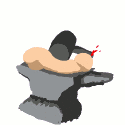|
Two chain falls! One on a gantry crane trolly to move the machine, the other wrapped around the gantry's I beam with a chain used simply to control the fact that the 1000lb head wanted to rotate 45 degrees the second it cleared the machine's bottom casting that it bolted into.
|
|
|
|

|
| # ? May 24, 2024 19:26 |
|
Congrats on the new mill RKH. I can't wait to see some pictures.  I was busy outside playing around in my new shed. Grinding down letter openers. 80 grit   120 grit. Sorry this picture isn't very good.   I'm pretty happy with these. The little one is a rusted spike I found in the yard, a gift for my mother. I like the rust pitting, gives it character.
|
|
|
|
This is a lathe sitting in my shop at work. Wish me luck with it. The largest challenge will be finding the loving TIME to work on it. That lathe from end to end (including the headstock) is ten feet. This is seriously the largest bandsaw I've ever seen. My boss just purchased it last week. I should have it put back together in a day or two. I'll post pics again after it's assembled. This thing is taller then a man by about 3-4 feet. Yes the saw is 9-10 feet tall. 
|
|
|
|
haha drat one of those fire cabinets you see in the BG is probably 6 feet tall and that thing dwarfs it. Whats wrong with the lathe?
|
|
|
|
RealKyleH posted:Whats wrong with the lathe? It is too awesome for this world.
|
|
|
|
RealKyleH posted:Whats wrong with the lathe?
|
|
|
|
Bad news: That is not a metal cutting band saw. After looking at the maintenance manual that came with it, it is for low and medium density materials. IE: foam, plastics. It may or may not be able to do wood. Good news: My boss should be able to sell this and make a hefty profit on it that we can use to buy some real metal-working machinery. (He bought it at double scrap price, which is real loving cheap.)
|
|
|
|
I was wondering how something with such a huge jaw would keep the blade from deforming while cutting anything substantial. But I kept my mouth shut because I don't know jack about industrial metalworking tools.
|
|
|
|
I now want a entire kitchen utensil set made of railroad ties.... thanks jerk
|
|
|
|
Godfrey posted:I now want a entire kitchen utensil set made of railroad ties.... thanks jerk Not mine, but relevant to the conversation. 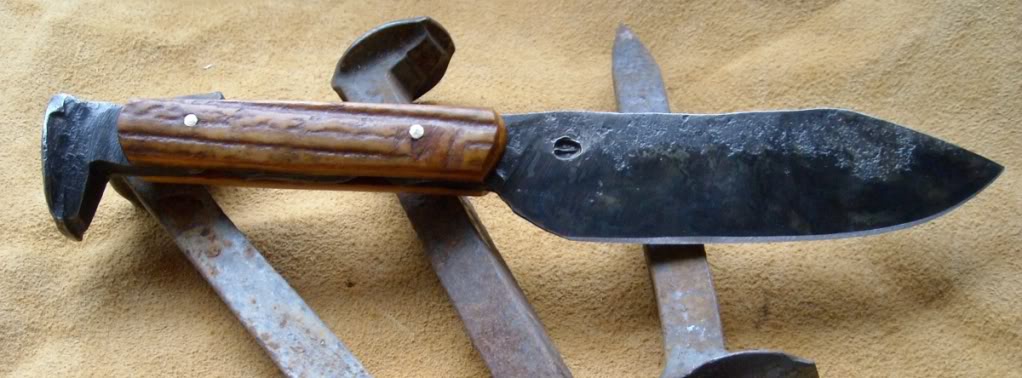 
|
|
|
|
I attended the Irricana Pioneer Acres annual show this weekend. I got some pretty interesting pictures of tractors and some pictures of trucks. But my main purpose was to participate in the blacksmith shop. We have all kinds of cool equipment. Now THIS is a lathe.  Powered from a jackshaft.  Which is powered by old Hercules here.   The tool post is mobile. You adjust the angle, the amount of force, and you apply pressure by squeezing the two foot long handles like they were shears. Completely manual, no leadscrews or anything.  It seems that no one had used it in years. None of the guys remembered anyone using it, so I had to figure it out as I went. Fun as hell. The shop is pretty cool too.    This is the big demonstrator forge.  Products of my labour for the weekend. Two letter openers, and a coal shovel, all made from spikes.  Three pokers. There are only two here because I sold one for 25 bucks, it wasn't cleaned up or anything.   I made a couple nails for kids too, but I didn't get any pictures of that.
|
|
|
|
That is an awesome place. Not only do they have some awesome equipment, it just feels so comfortable there, like you could spend your entire day there in serenity.
|
|
|
|
poo poo yes, dudes. I just called a dude who posted a Champion blower on Craigslist. He answered the phone, and it's an old guy with a country voice. I ask if it's operational: "Heck yeah!". He posted it for $200, I offered him $150 (probably not a screaming deal, but it's worth it to me). Going to pick it up in a few minutes. Now I have a well-worn hammer, a passable forged anvil, a post vice, soon a working blower, and a place to set it all up and use it. I'll be buying a camera with my next paycheck, so get ready.
|
|
|
|
Hello, I made some hinges for my gates the other night.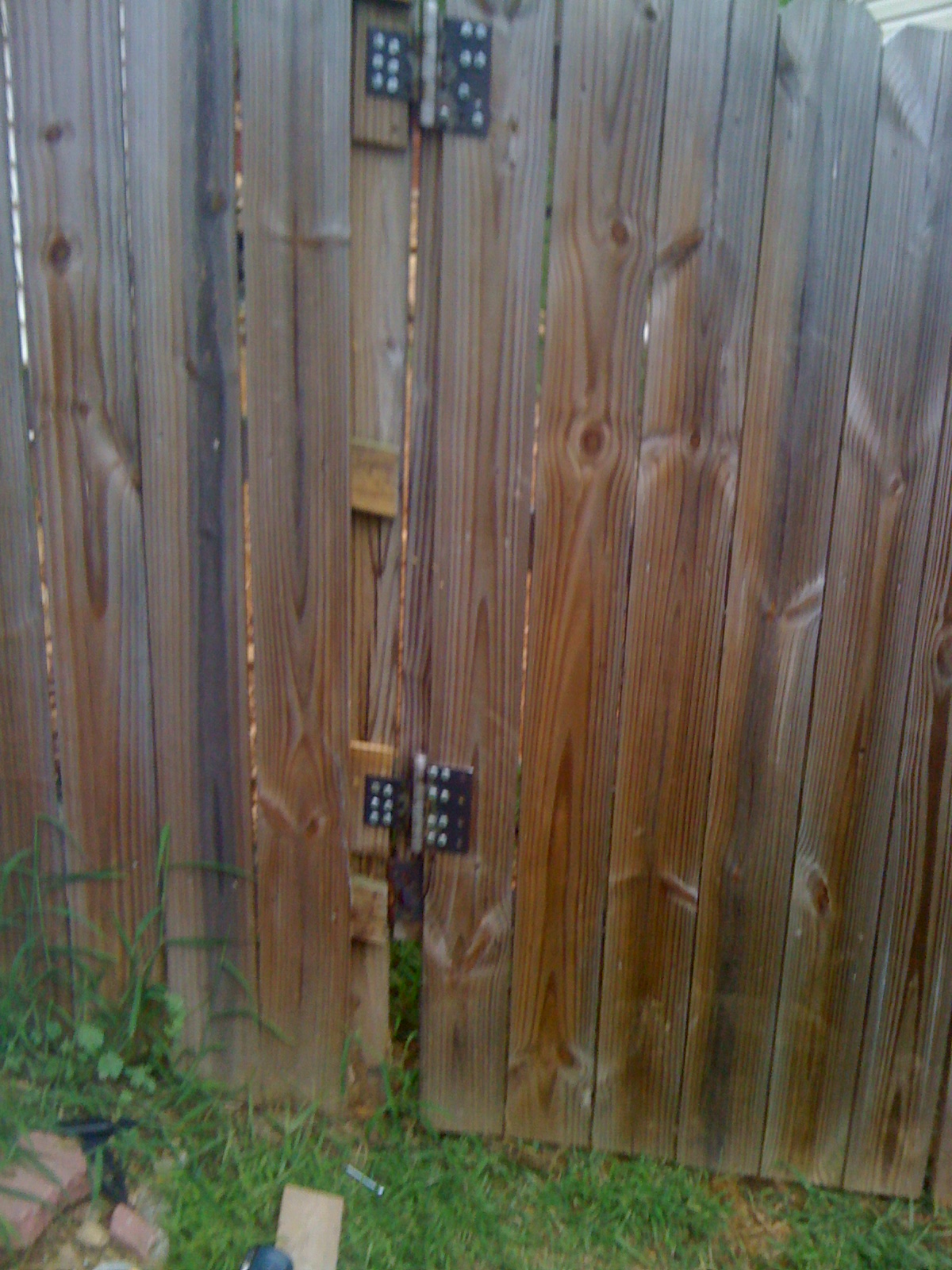 Click here for the full 1200x1600 image. 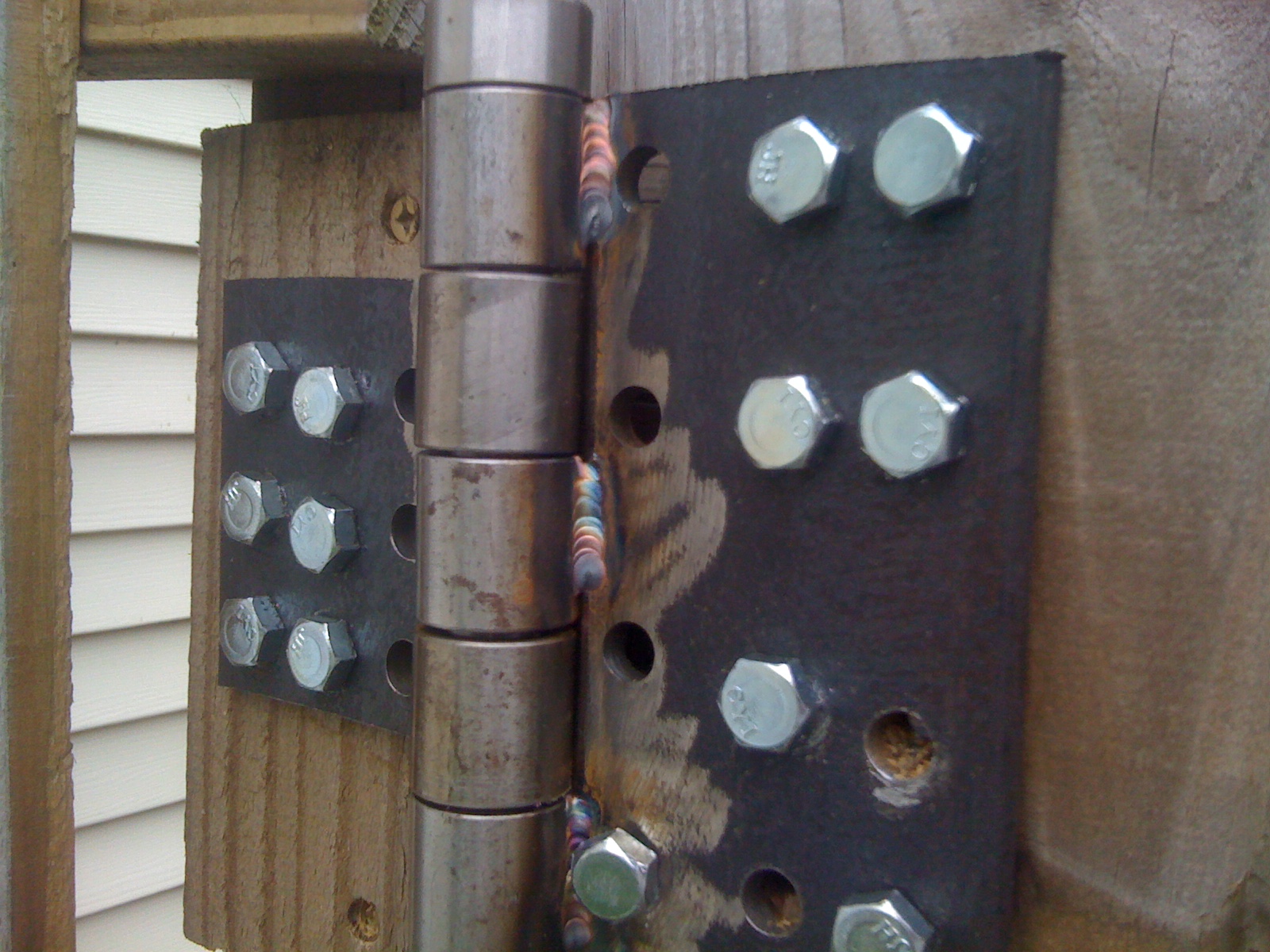 Click here for the full 1600x1200 image.  Click here for the full 1200x1600 image. 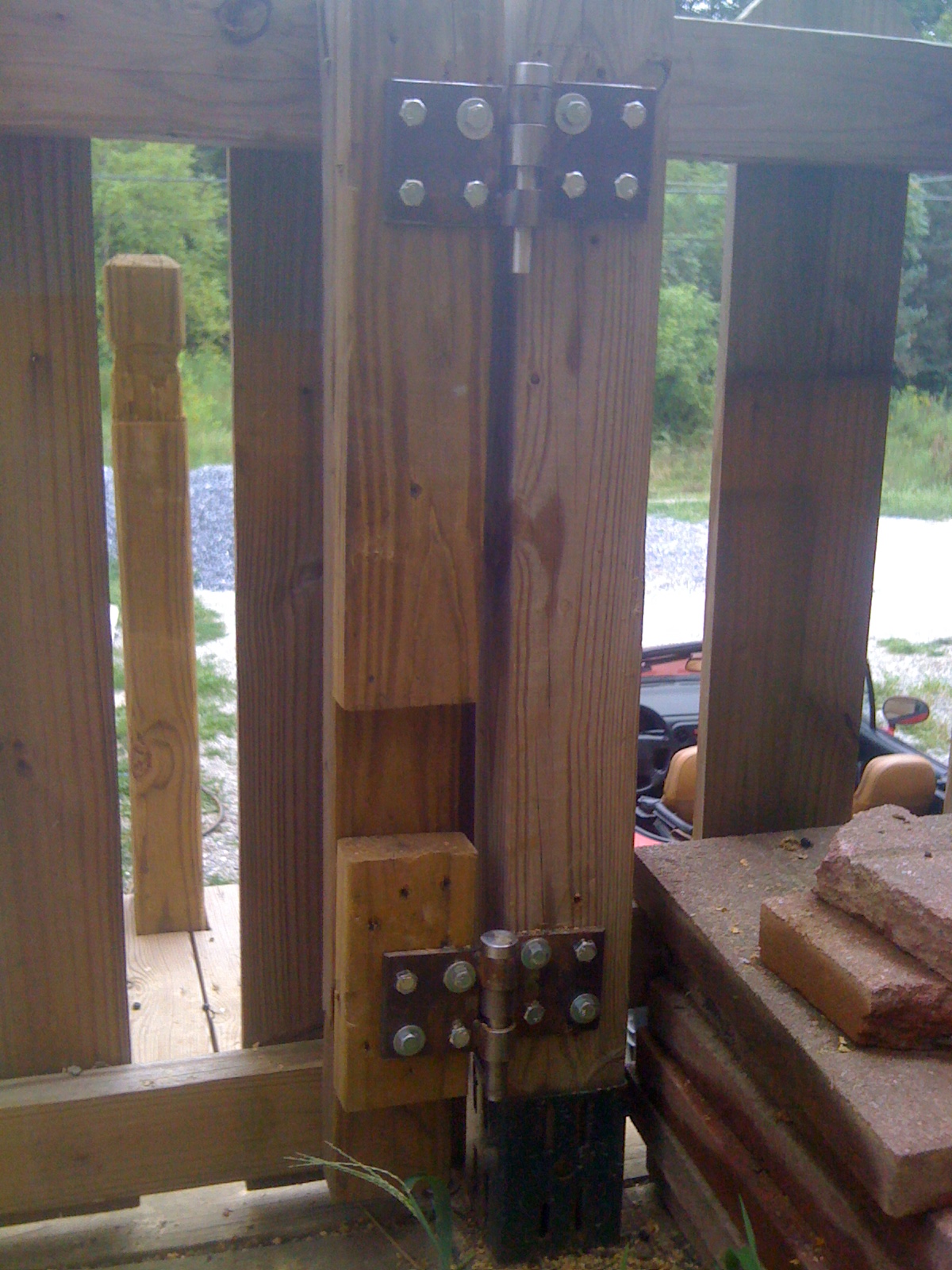 Click here for the full 1200x1600 image.  Click here for the full 1200x1600 image. and here's a hook I made for a flower pot a while ago  Click here for the full 1200x1600 image. The hinge pins are 5/8" diameter and for the hook I cut coarse threads and then tapered the end to make a sort of lag screw on the end Chauncey fucked around with this message at 21:43 on Aug 14, 2010 |
|
|
|
Nice work. What kind of TIG welder/torch do you have?
|
|
|
|
Very nice. Though I would clean the scale off and paint them, you're going to get some huge rust coloured stains running down that nice fence 
|
|
|
|
Yeah I thought about the rust colored stains. The plates are covered in mill scale except for where I ground them for welding. The pins and sleeves and stainless so I won't have toooo much to worry about. But I definitely thought of that and if it starts to go that way I am painting them bitches. Thank you for the comment! The welder is a Miller we have at work. I this it may be a Dynasty somethin or other. All I really know is it has an integrated chiller and uses 480 volt service. It is a nice welder!
|
|
|
|
Does anyone here gas-weld thin aluminum? I got the idea of making a rowboat, but I want to use aluminum instead of wood. I already had an oxy-acetylene setup, and the two ways that small aluminum boats are made is riveting and welding, so I assumed I'd use welding. All my regular torch (with small tips) did was blow holes, so I thought that if I'm gonna make holes, they might as well be smaller holes.... I bought a "ArTorch" jewelry torch that hooks onto my regulators, and blow-throughs are much less of a problem with the tiny tips. I also got a tinman aluminum welding lens--which helps a HUGE amount, but still doesn't make it easy. I figure I need to be able to weld .050" aluminum to do this, though I have noticed that .080" and .100" are much easier to do. The metal is very touchy in terms of the temperature range it needs to be in. The best welds I've gotten in the .050" aluminum appear to be solid, but don't look anything like what kind of welding I can do easily on thin steel. ~
|
|
|
|
I'm not saying you can't do it, but the only industry I've ever heard about that still gas welds aluminum is the aerospace industry. There is a gentleman on the Hobart weld forums who happens to do such a process for such an industry. His advice, or a good TIG machine that can do High Frequency AC is your best bet.
|
|
|
|
dv6speed posted:... -or a good TIG machine that can do High Frequency AC is your best bet. Aside from being even slower than a gas torch, it tends to leave a lot of pinholes in the weld that need to be found and closed, and also often you get cracking right next to the weld since the HAZ is so small. That's why it was never commonly used in production, even for welding smaller boats. There are a lot of welded aluminum jonboats in the US, but they are mig-welded, and the metal is usually at least .100" thick. They use metal that thick because they cannot reliably mig-weld on aluminum much thinner. ------- The other possible way is riveting, which I guess I could do also--I already have a big enough air compressor to run a air hammer, and that would be the main expense. There are 40+ years-old canoes riveted together that are still watertight. I don't know what they lined the seams with but now you could use teflon tape, which is almost perfectly chemically-resistant..... ~
|
|
|
|
Yeah, I would definitely just rivet it. Gas welding stock that thin is just asking for problems. And aluminium is a pain in the rear end to weld at the best of times. As for waterproofing, I think I would just spray some kind of truck bedliner inside the boat. It would add weight, but man, that interior would be loving indestructible. On an unrelated note, anyone here ever made a scythe? I think I need something to chop down my tall grass before I can cultivate the soil underneath it.
|
|
|
|
Never made a scythe, I don't have big enough stock for it at the moment, but I've bent and used those green T posts that are used for barbed wire fences as a makeshift scythe before. e: just realized how completely unhelpful this post was. I was going for the "use what might be lying around for other than its intended purpose" thing rather than trying to make it correctly. Whoops. Zquargon fucked around with this message at 22:57 on Aug 16, 2010 |
|
|
|
Slung Blade posted:Gas welding stock that thin is just asking for problems. And aluminium is a pain in the rear end to weld at the best of times. Thoughts on "alumaloy" or other aluminum bonding materials? Seems akin to brazing, and it appears to be versitile enough to handle that kind of application. I plan to use some on an intake manifold I'm fabricating, but I haven't actually used it yet.
|
|
|
|
Can aluminum be spot welded? I remember hearing a decade or so ago about some car manufacture using a seam-welding process that to me seemed to be little more than than spot-welding but using a copper wheel that moved in a line instead of a single spot weld. Or I may be mis-remembering things, I dunno. Almost certainly not applicable in this case, unless you really wanted to gently caress with trying it.
|
|
|
|
Slung Blade posted:On an unrelated note, anyone here ever made a scythe? I think I need something to chop down my tall grass before I can cultivate the soil underneath it. No, but I've made blades. Leaf springs from a truck make excellent base stock for blades, because they're pretty cheap spring (carbon) steel. I think a spring a couple inches wide and a 3/8" or more thick would be more than enough to make a full grim-reaper scythe blade. All the normal techniques for carbon steel working apply - anneal first, don't work it cold (deep cherry red is your final blow), etc. That said, a decently-sized forge is a big plus. Depending on how big you want your blade, it can get very unwieldy working the middle bit.
|
|
|
|
jovial_cynic posted:Thoughts on "alumaloy" or other aluminum bonding materials? Seems akin to brazing, and it appears to be versitile enough to handle that kind of application. I plan to use some on an intake manifold I'm fabricating, but I haven't actually used it yet. Speaking of pickling aluminum, I have some flux for soldering aluminum, but I still don't know what to use to pickle it before hand with. That being said, I haven't tried hard to figure it out either. Fire Storm posted:Can aluminum be spot welded? I remember hearing a decade or so ago about some car manufacture using a seam-welding process that to me seemed to be little more than than spot-welding but using a copper wheel that moved in a line instead of a single spot weld. Even in steel, "spot welding" makes for a very lovely weld that you only find on thin gauge steel in products that come from overseas and break shortly thereafter. There are a number or really fascinating industrial welding processes that are controlled by a machine but I don't know enough about them to tell you how what you are referring to would differ from spot welding.
|
|
|
|
Just remembered another thing about a scythe blade: it's sharp on the inside of the curve. That bears special attention. When you start with bar stock and draw out one side for the blade, the stock will curve in the opposite side. So ordinarily you'd bend the stock first, then work the inside of the curve down, and it winds up basically straight at the end. To sharpen the inside of a curved edge, you'll need to exaggerate this a bunch. So curl your stock into a u-shape, then work the inside edge, and stop when you get to the desired amount of curve.
|
|
|
|
Yeah I think I'll have to do this next time I'm at the guild shop. I could do a straight blade in my gas forge, but I'd never get it inside with the curve. I haven't used my charcoal forge in ages, and I don't think it's big enough anyway. I want to build a long tempering forge someday soon as well, this would give me a good excuse. Jovial: never heard of alumalloy. I've only tig welded aluminium, and it was only a few pieces at that. I mostly just stick with the ferrous stuff, sorry man 
|
|
|
|
I REAAAALLLYY have the urge to spend some money I have put away on a benchtop lathe. I would need it to be able to turn tapers and do threads. I would also like it to be able to work on pieces 18 inches long or more. Any recommendations? I have used the Shurline stuff before, but I don't think they make them that big, and overall they seemed kinda flimsy. CNC would be neat as well, but I don't have any experience in that. I will be turning tool steel, brass, and maybe bronze. I can't get a full sized lathe because I don't have that kind of money, or that kind of space. My work does have a full size lathe, but it doesn't have that much tooling, and I would prefer to have my own to really go nuts on. Is there a special tool I need to turn threads on the inside of a piece, or do I just need to align the cutting piece at a good angle?
|
|
|
|
You won't get something that can do a real 18" long workpiece in a table top lathe. It is not going to happen. You'll either have to accept a shorter workpiece, or figure out where to put and how to pay for a bigger lathe. As far as cutting tool for inside threads, it's a specially shaped cutting tool, that looks something like a lock pick.
|
|
|
|
dv6speed posted:You won't get something that can do a real 18" long workpiece in a table top lathe. It is not going to happen. You'll either have to accept a shorter workpiece, or figure out where to put and how to pay for a bigger lathe. Is the 18" not going to happen because of accuracy over that distance, or because they don't make them long enough? This one for example is 19" http://www.amazon.com/M1049-9-Inch-19-Inch-Bench-Lathe/dp/B001R23SGS/ref=sr_1_1?s=industrial&ie=UTF8&qid=1282013255&sr=1-1 I need a longer working area because I need to make a tapered mandrel for trumpets so I can form my own leadpipes (the long tube you blow in to where the mouthpiece goes)I figured 18"+ would give me enough room to experiment with different lengths and taper angles. http://www.atlas-machinery.com/products/King-Industrial-KC-1022ML-10x22-Belt-Drive-Metal-Lathe Actually, this one (although currently out of my price range) is available locally. Brekelefuw fucked around with this message at 03:56 on Aug 17, 2010 |
|
|
|
Brekelefuw posted:Is the 18" not going to happen because of accuracy over that distance,
|
|
|
|
Warning: I am not a trained professional....Brekelefuw posted:I REAAAALLLYY have the urge to spend some money I have put away on a benchtop lathe. quote:I have used the Shurline stuff before, but I don't think they make them that big, and overall they seemed kinda flimsy. quote:CNC would be neat as well, but I don't have any experience in that. quote:I will be turning tool steel, brass, and maybe bronze. To that end, you can buy lathe tool bits already ground for you--but that is very overpriced, and you will need to re-sharpen them anyway, as well as grind them into special shapes and angles. In the long run it is much cheaper and easier to just buy HSS blanks and grind your own lathe tool bits. quote:I can't get a full sized lathe because I don't have that kind of money, or that kind of space. ... For what I paid for my benchtop machines, I could have bought used full-size ones, but I simply had nowhere to put them. Many machinist forums don't have any section about China machinery, a few will even delete threads asking about them. One machinist forum hospitable to the China benchtop machines is the Home Machinist forum: http://www.chaski.org/homemachinist/index.php quote:Is there a special tool I need to turn threads on the inside of a piece, or do I just need to align the cutting piece at a good angle? IF the hole is small enough that you can find a tap for the threads, then another trick you can do {if you want perfectly-perpendicular threads through the bore of a tube} is to cut the first inch or so with a lathe, and then finish the hole tapping it by hand. The hand tap will cut straight, as long as it is started straight. I never got much accessories for my lathe, there just wasn't that much to buy. It was the milling machine that has a pile of expensive extra stuff. I have one of the Grizzly lathes (the G9972Z 11" x 26"). It has its issues, but I still have a lot of fun playing around with it. The one thing I would caution anyone about buying the very-small (China) lathes is that many of them only come with a 3-jaw chuck. That 3-jaw chuck is supposed to be self-centering (like a drill chuck is) but it centers in a rather vague sense of the word. On a lathe you want a chuck that will center to .001" at least, and most of the China chucks will not do that, and there's no easy way to correct them. A lathe that won't center stuff isn't worth dog crap,,, and so you need a 4-jaw (independent) chuck, and a magnetic stand+dial indicator to chuck workpieces in the lathe and center them properly. The lathe I got came with a 3-jaw and a 4-jaw chuck. I left the 3-jaw on there for a while, because I figured that it was self-centering, so why not???...... but it turned out to be crap. It would "center" about .006" off, and I couldn't ever get anything re-centered after cutting on it, taking it out and putting it back into the lathe chuck. So the 3-jaw came off, and is a doorstop now. The 4-jaw is on there for good, and I just center everything manually with the dial indicator. ------ Since you mentioned cutting [perfectly straight-sided] tapers: there are lathe attachments just for doing that... but the bad news is, they are not available ready-made for most lathes. Many people build their own. Googled: http://www.google.com/#hl=en&source...7c7b863973b935b You can still "manually" cut tapers by making a sort of stair-stepped bunch of cuts, and then smoothing them with a hand file (while spinning on the lathe). This I'd think would be good enough for making a mandrel for a horn, but if you want a PERFECT taper, you're going to need a machine with a taper attachment. --------- Also in case you did not know, horn bells are made on lathes too. The technique is called "metal spinning" or "spin forming". One video: http://www.youtube.com/watch?v=UP_gq1ahrmk Some of these videos show purpose-built spinning lathes, which do not have a carriage (a toolpost holder that moves left and right). Instead they have a stationary rack with some peg stops in it. You don't need a special lathe, you just crank the carriage out of the way and build a peg-stop rack attachment for the table the lathe is (!hopefully!) bolted to. ~ edmund745 fucked around with this message at 11:38 on Aug 17, 2010 |
|
|
|
Wow, thanks for the help and linksquote:Brass is very "grabby". You will need to find out how to grind the lathe bits for brass, and you will need a way to grind them. A small hand-held grinder like a Dremel will work, but it will be very slow. Toss a few bucks for a cheap 6-inch bench grinder to do your lathe bits on. I have machined brass many times before, and have some training on how to grind bits. It has been a while since I have ground a bit though. quote:IF the hole is small enough that you can find a tap for the threads, then another trick you can do That is a neat trick, but the threads I would be cutting will be for top and bottom caps on trumpets, which are roughly .800 thousandths in diameter and roughly a half inch in length, so getting a tap for that would most likely be out of the question. I think right now, the taper I would need to cut would be based as closely to some physics formulae as possible, so manually filing down my taper would be difficult to get the same results. I am a brass instrument repair technician who hopes to get in to trumpet making in the future. I love seeing the videos of people spinning bells and aluminium things. Bells are done slightly differently than the lamp shade video you posted. Typically bells are cut out of a sheet, formed over a mandrel with a mallet, brazed at the seam, and then finally burnished to the final shape over a high precision mandrel on the lathe. dv6speed posted:You got it. No way to keep a tabletop lathe bed that long from twisting. Are even the heavy benchtops that look to be cast prone to that much twisting? If bolted to a bench? Can this be reduced by making smaller cuts? Typically I only make cuts that are 2-15 thousandths at a time.
|
|
|
|
Brekelefuw posted:Are even the heavy benchtops that look to be cast prone to that much twisting? If bolted to a bench? Brekelefuw posted:Can this be reduced by making smaller cuts? Typically I only make cuts that are 2-15 thousandths at a time. If someone put a gun to my head and forced me to buy a modern import table top lathe, I would probably find a nice piece of plate, AT LEAST 1/2" thick, 1" even better, and bolt that to an extra sturdy bench, and bolt the lathe to the plate.
|
|
|
|
dv6speed posted:Yes. ANY lathe bed, tabletop or not, is prone to this. The tabletops will experience it more so, however. I have no problem bolting things to other things if it means I can turn large pieces of round metal in to smaller pieces of round metal. I did some measurements today, and realised that a trumpet leadpipe is only 9.5 inches long on average, so an 18"+ bench top isn't needed. I guess I would need one to be 12-15 inches so I can make my mandrels a bit longer if I want to mess with the ratios of the tapers I make.
|
|
|
|
Re: Alumaloy It works, but I would not fabricate a manifold out of it. It melts at about 760 F, which an intake manifold shouldn't ever see, but which is uncomfortably low for any application that generates heat. It's like solder in that it goes from solid to liquid in an instant once the temperature threshold is passed. I've built a few bike racks (for bikes, not cars) using it, with a fair bit of success. Good prep is essential, as is good design. Some joints that might be perfectly weldable just don't work for aluminum brazing. Complex assembly is also nearly impossible, because you need to do a number of steps fairly quickly: scrub oxides off both surfaces with a stainless brush while hot; melt some material on both surfaces and scrub it in; put hot pieces together; add additional material around seams. The demonstration videos, which often show a guy attaching a tube or round stock to a piece of flat stock, show what works best. When you take a hammer to it, the metal really does break before the weld/braze/solder/whatever you want to call it. But good luck getting that kind of fitment on a part you're building to do something useful.
|
|
|
|
The "alumaloy" propane welding rods (soldering) can work for some things, but not all. Easiest way to find out is to see for yourself. It doesn't cost much to play with even if you've got no welding torch, since a $20 propane torch is hot enough. Many small hardware stores sell it, AFAIK it is generally called "aluminum repair rod". Be sure that you're buying the stuff that you can use with a PROPANE torch. Most brands have the flux already in the rod metal. Forney, Alumiweld, Dura-fix, Muggy Weld, Aladdin 3-in-1 and HTS-2000 are a few brands. Just get whatever cheapest brand your local store has, they all work about the same. Current prices seem to be around $25-$30 a lb. All these rods are mostly zinc and the rest aluminum except for a bit of stuff that acts as flux; there's no expensive ingredients in any of them. Aluminum needs to be CLEAN to be soldered (or welded)... wash it in warm water with Comet & warm water rinse, then wash it again with dish soap & warm water rinse then dry it. It must be clean enough to EAT off of. Right before soldering, brush it with the wire brush where you want the solder to stick (so that fresh metal shows). --------- The main problem I've had with it is that it's generally not possible to do multiple joins close to each other, since the heating of the second spot will tend to melt the first. Also the join needs to be LEVEL, since the stuff turns very thin and tends to run off if it is tilted at all. --------- The classic "hole in the bottom of a soda can" seems like something almost all of these places use as a demo, and yet it is a good example of a perfectly-staged test. It's not fake, it does work--but it is basically ideal conditions. Because of how the bottom of an upside-down soda can is domed DOWNWARDS in the center, the stuff doesn't run off in all directions--it runs towards the center. So they can patch a fairly-big hole relatively easily..... If they cut the bottom of the can off and left it sitting right-side up (so that they were trying to patch a hole at the TOP of a dome) it would be quite a bit more difficult to do, because the solder would tend to run off down the sides, and not stay in the center near the hole. ~
|
|
|
|
Yesterday, I was driving through town and happened to see truck with a bunch of large pieces of scrap metal... including a 3-foot section of railroad track. I figured he was probably headed towards a scrap recycler, so I followed him a few miles until he pulled into a metal scrap yard. I hopped out and asked him if I could buy the track off of him before he dumped it, and after a quick bartering session, I walked away with a chunk of metal for $10.   About half an hour with the cutting torch later, and I had two pieces. I used to have this one that I found at a garage sale, but I lost it in the move from Washington to California.  
|
|
|
|

|
| # ? May 24, 2024 19:26 |
|
Awesome find Jovial. May I suggest this as reading though? http://www.anvilfire.com/FAQs/RR-rail_anvils.htm 
|
|
|











